- US 10-year real yields turn positive
- Netflix earnings disappoint
- European stocks rise on positive earnings
- On Thursday the Eurozone publishes CPI data
- US initial jobless claims are released on Thursday
- Fed Chair Jerome Powell and ECB President Christine Lagarde discuss the global economy at the IMF on Thursday
- MSCI Emerging Markets rose 0.1% to 1097.08
- MSCI Asia Pacific Index rose 0.66% to 181.65
- The euro rose 0.6% to $1.0856
- The offshore yuan rose 0.3% to 6.4369 per dollar
- Brent crude rose 0.9% to $108.21 a barrel
- Spot gold rose 0.1% to $1,953.13 an ounce
Key Events
On Wednesday, higher Treasury yields and lower than expected earnings pressured futures on the NASDAQ while contracts on the Dow Jones, S&P 500 and Russell 2000 traded marginally higher along with European stocks.
Gold and the US dollar slipped.
Global Financial Affairs
Yesterday's trading in the US resulted in the sharpest gain for Wall Street in a month. However, this morning in Asia NASDAQ 100 contracts are underperforming after Netflix (NASDAQ:NFLX) reported earnings after the close which included news that customer numbers had dropped for the first time in a decade.
Shares of the streaming giant lost 25% of value in after-hours trading, and are even lower today in premarket trade as investors worry that consumers are starting to watch their pennies with inflation continuing to run high. Netflix blamed growing competition and password sharing for the shrinking customer numbers.
In Europe, equities are volatile with the STOXX 600 recovering today after sliding 0.77% on Tuesday. Although food and beverage giant Danone SA (EPA:DANO) extended its rally to a third day, adding 9.4% to its shares after posting better than expected Q1 sales, traders remain concerned about the ongoing conflict in Ukraine as well as looming higher interest rates.
However, the French food giant said that despite rising commodity prices it is maintaining its 2022 earnings target.
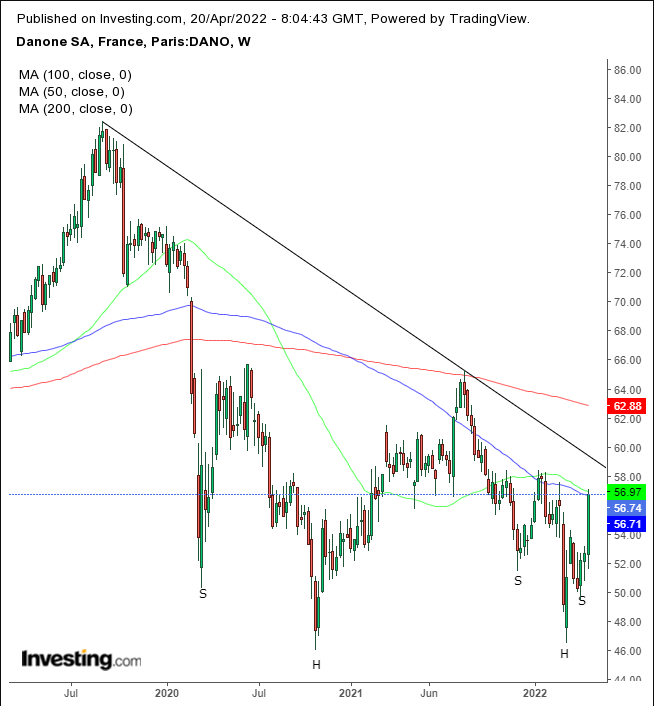
Unfortunately, as things stand, we suspect that the stock's advance is suspect. It's a corrective move within a downtrend.
If, however, the price overtakes the 58 mark, it may complete an H&S bottom, whose neckline is the 50 WMA. That could create the momentum to help the price cross over the 200 WMA, completing a double top. We wouldn't be surprised if the price falls back before it continues higher, though, corresponding to the price action of 2020, completing a combination H&S bottom.
Shares of Dutch brewer Heineken (AS:HEIN) climbed as much as 4.3% after the beer maker reported a boost in first-quarter sales as bars and restaurants in Europe reopened which enabled the Dutch giant to achieve its forecast.
The food & beverage industry was the driver of today's recovery in the STOXX 600 but it was also assisted by the banking sector even though shares in Swiss banking giant, Credit Suisse (SIX:CSGN) declined 1.9% after it provided weak guidance of a first-quarter net loss due to the continued fallout from the Russia-Ukraine war as well as increased legal provisions.
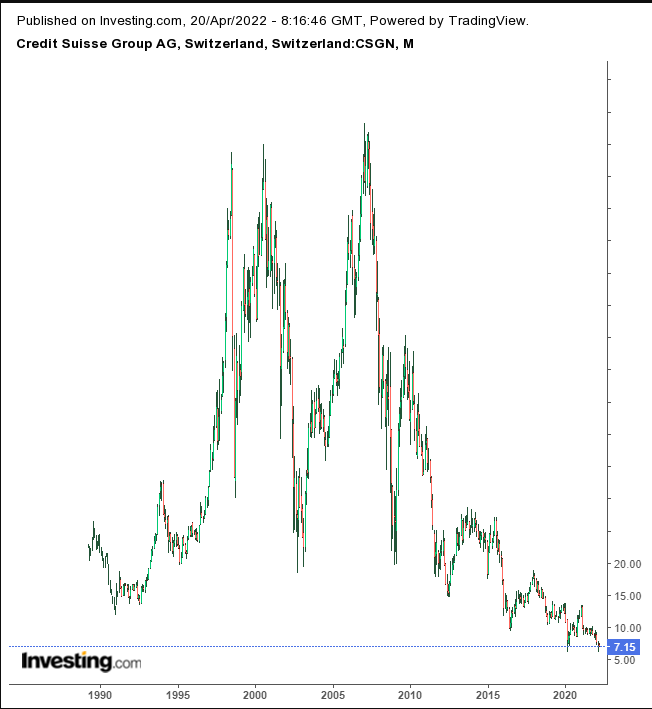
The bank's stock is trading now 9.3% below its Mar. 7 all-time low.
Earlier Wednesday, most Asian benchmarks tracked the rally on Wall Street.
However, the session was beset by "noise," as trading was fickle amid high US yields, and China's harsh public health policies failed to reign in the virus spread. The pandemic lockdowns have now gone far beyond Shanghai—the country's largest city and its financial center. There are currently social restrictions in 45 cities.
In Japan, the Nikkei 225 outperformed among the major Asian markets, even as the yen continued to slip. A weak yen boosts the country's exports, which are crucial. In 2019, international trade made up almost 35% of Japan's GDP whereas in the same year only 26.3% of US GDP was due to international trade.
The 10-year real yield turned positive for the first time since stocks bottomed in March 2020 at the start of the global pandemic. Analysts hope that normalizing yields is equivalent to the market's return to the old normal.
Investors seem to be considering realigning portfolios to account for higher interest rates, which traditionally siphon capital away from risk assets, such as equities, as well as non-yielding assets, such as gold.
Traders are trying to figure out how much significance to assign to past performance as the world radically changes from an environment of peace and ultra-low interest rates to higher interest rates as well as the uncertainty of war.
On Tuesday, 10-year Treasury yields closed just below 2.5% and reached over 2.85% today, the highest level since December 2018.
Normalizing yields are bad news for equity investors. It means that traditional debt investors, such as insurance companies, which had been investing in dividend-yielding equities due to the low yields available from Treasuries during the coronavirus pandemic are now moving funds into the sovereign bonds.
The dollar fell, erasing a day and a half of gains.
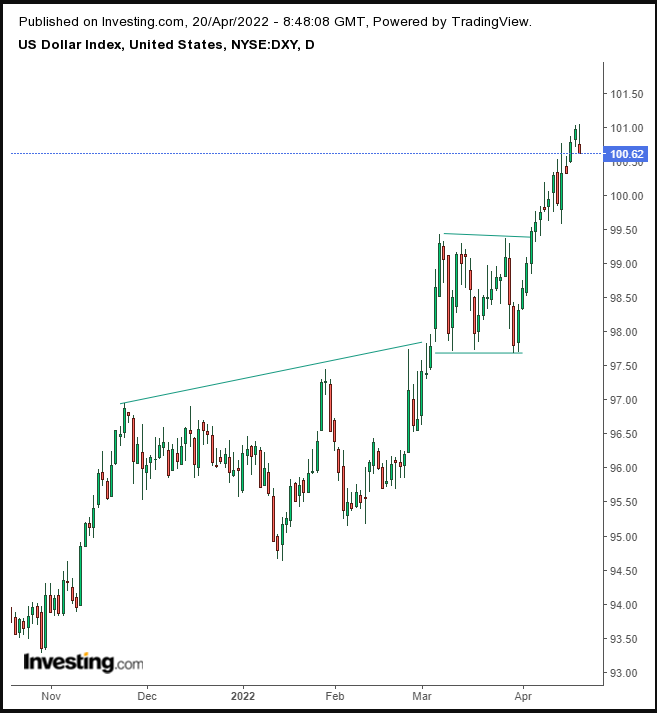
We expect the greenback to keep advancing after completing two bullish patterns.
Gold has fallen for the second day, but the recent ups and downs have formed a pattern.
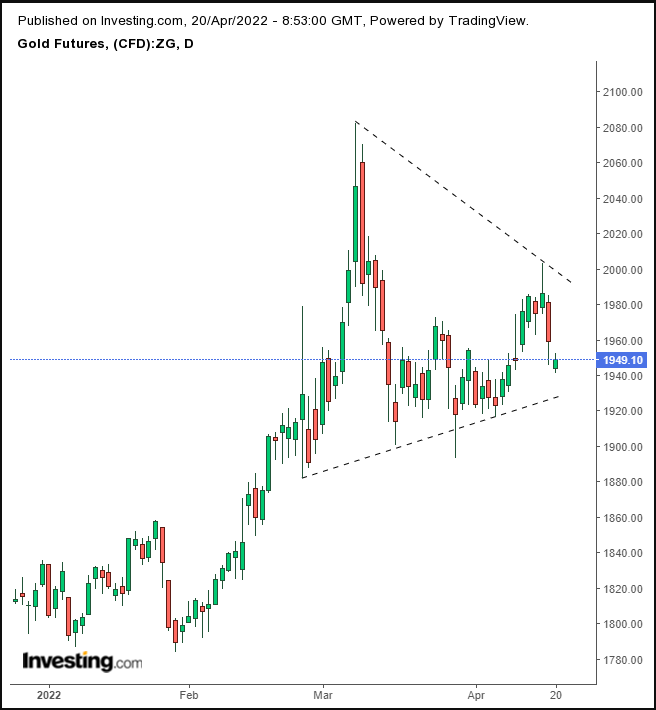
The last peak and trough allowed the price to extend trendlines to include the lateral movement of a Symmetrical pattern. Although the equal determination by bears and bulls means a breakout could go either way, there is an expectation it will be in the direction of the underlying trend, which is up.
According to economic theory, the price of the yellow metal should collapse amid rising yields and a strengthening dollar. However, the market is a complex jigsaw puzzle and the price may climb due to its haven status if the war in Ukraine deteriorates further.
Rising Treasury yields and a strengthening dollar should siphon investment funds away from non-yielding cryptocurrencies. Additionally, pumping the economy with cheap money pushed investors to digital coins, especially Bitcoin, whose production is capped. Therefore, reducing liquidity should also dry up demand for the leading cryptocurrency.
Bitcoin was flat after a two-day jump, blowing out a bearish pennant.
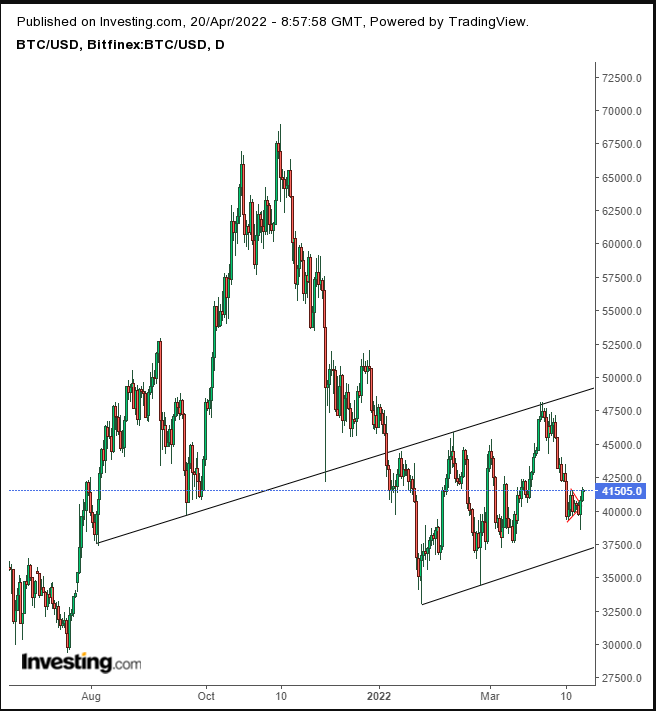
The digital token is trading within a rising channel whose top is the neckline of a large H&S top, which we still consider the technical driving force on the chart.
Oil rebounded from Tuesday's sharpest daily decline in nearly two weeks after data showed a drop in US inventories.
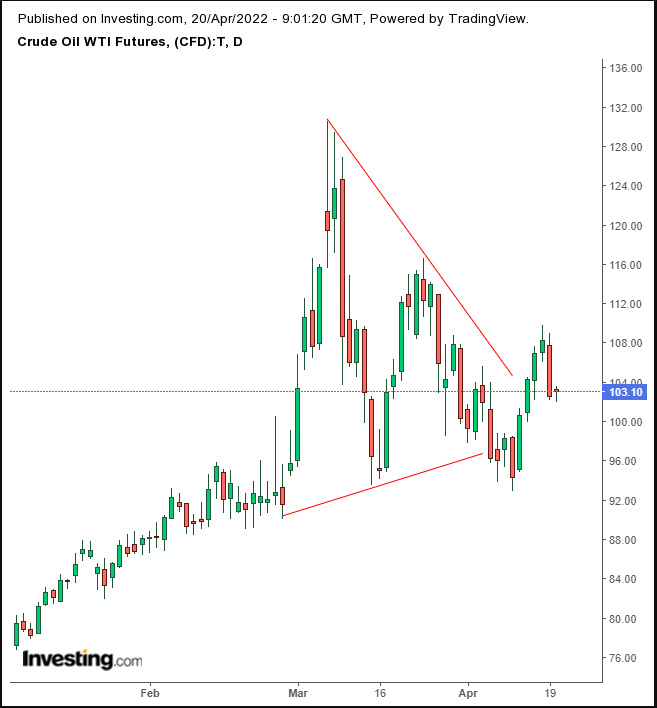
The price has been meandering through its vertex, making the pattern suspect as an accurate measure of a cohesive collective dynamic. We need to see a succession of peaks and troughs to feel confident about the trend.
